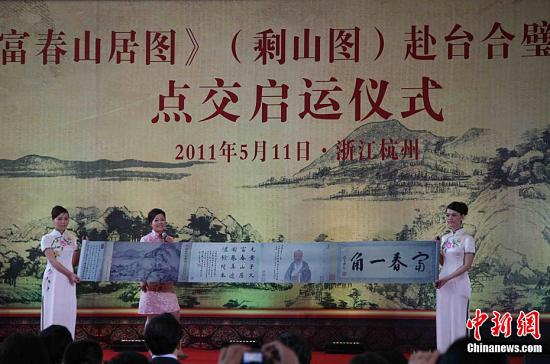Parts of torn ancient Chinese painting brought together
Visitors to Taipei's Palace Museum from June to September can view a Chinese painting in its entirety for the first time since it was burnt into two pieces 360 years ago.
 |
|
"Dwelling in the Fuchun Mountains" by famous Yuan Dynasty painter Huang Gongwang was exhibited in Zhejiang Museum on May 11,2011. |
"Dwelling in the Fuchun Mountains," a painting by famous Yuan Dynasty painter Huang Gongwang, was damaged in a fire and broken into two halves in 1650.
After changing hands several times, the right side of the painting ended up in the Chinese mainland's Zhejiang Museum, while the left side of the painting found a home in Taipei's Palace Museum.
An exhibition for the newly reunited painting opened in the Palace Museum on Wednesday and will run until Sept. 25 this year.
The left part of the painting was among some 600,000 items moved by the Kuomintang (KMT) government to Taipei from Beijing's Forbidden City before the KMT fled to Taiwan in 1949. These relics were used to found the Palace Museum in 1965.
The scroll-style painting vividly depicts the banks of the Fuchun River in Zhejiang Province during the autumn season. It is regarded as one of the greatest examples of traditional Chinese landscape painting.
"As a painter of traditional Chinese ink paintings, I have never seen this masterpiece before. It is like a dream come true," said He Shuifa, a renowned painter from the mainland, at the exhibition's opening ceremony.
He said that the artist completed the painting when he was 82 years od, and that it is an abstract representation of the painter's life.
"Only a dozen of Huang's paintings have survived until now," He said.
Huang's work marked the start of a new school of Chinese painting referred to as "Literati Painting," which dominated Chinese art for centuries.
Painters from the school were also poets, intellectuals and calligraphers. They turned painting into a comprehensive means of self-expression by writing poems and short essays in the margins of their works.
"Without improving relations across the Strait, we would not have the chance to see this reunion," said Li Daoxiang, a professor from the Academy of Chinese Culture.
The Chinese mainland and Taiwan have been estranged since a civil war in the late 1940s. The two sides resumed transportation and trade exchanges in the 1980s.
The Palace Museum in Taipei hosted its first joint exhibition with the Palace Museum in Beijing in 2009.
"The two museums have made great efforts to settle their disagreements, which has laid a foundation for future cross-Strait cooperation," Li said.
"As economic links between the two sides become closer, people from both sides should work together to recall and rebuild ancient Chinese culture," Li said.
A delegation from the mainland, headed by Zhao Hongzhu, the party chief of Zhejiang Province, attended the opening ceremony.
"The exhibition is the result of cooperative efforts from both sides," Zhao said at the ceremony.
Premier Wen Jiabao first called for a "reunification" of the painting's two pieces in March of last year.
After several talks following his comments, the Zhejiang Museum and Taipei Palace Museum signed a memorandum and finalized arrangements for the exhibition in January of this year.
In a meeting with Zhao on Tuesday, Lien Chan, honorary chairman of the KMT, hailed the reunion of the painting's pieces as a "historic event."
The two parts of the ancient painting have been placed together in a 16-meter-long glass cabinet. A three-dimensional animated version of the painting is displayed nearby on a 40-meter-long screen.
The animated version allows audiences to interact with the painting. For example, if a visitor says "hello" in front of the screen, a fisherman depicted in the painting will turn his head to the visitor.
"The animation helps visitors to fully enjoy the painting's beauty. We wanted to pay tribute to the ancient master in a modern way," said Lin Juin-ting, a Taiwanese artist who created the animated version.
Cultural performances, including dances, operas, calligraphy demonstrations and poem recitations, took place in Zhejiang's city of Fuyang on Wednesday to celebrate the painting's reunion.
A landscape painting created by children from Taiwan and Zhejiang was displayed during the performances.
Zhang Jinming, the mayor of Fuyang, said that he hopes the reunited painting can be exhibited in Fuyang in the future.
 0
0 






